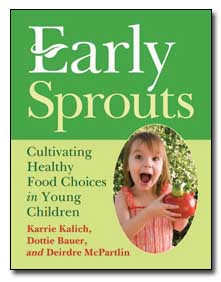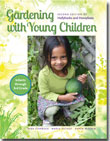Gardening: with limitations and some success
By Peggy Ashbrook
Posted on 2016-03-14
When the preschool moved, the new location presented many obstacles to gardening with children:
- Sloping ground.
- Mature trees shading much of the area.
- English ivy covered portions of the available area.
- The play area had not yet been constructed so the choice of “where” could not be made.
I turned to the resources of the early childhood education and science education communities to get some advice.
 The National Science Teachers Association’s Learning Center has wonderful forums for asking and providing advice and information on many topics. It is free to all to register! I posted in the Early Childhood forum with a post title of “Gardening at school with young children” and heard from many of you with ideas for making a successful garden.
The National Science Teachers Association’s Learning Center has wonderful forums for asking and providing advice and information on many topics. It is free to all to register! I posted in the Early Childhood forum with a post title of “Gardening at school with young children” and heard from many of you with ideas for making a successful garden.
 I found beginning instruction and great encouragement in Early Sprouts: Cultivating Healthy Food Choices in Young Children by Karrie Kalich, Dottie Bauer, and Deirdre MdPartlin (2009 Redleaf Press). Reading, “The most important things are a positive attitude and a willingness to try,” and the details about maintaining the garden were motivating. The work of these authors continues at the Early Sprouts Institute.
I found beginning instruction and great encouragement in Early Sprouts: Cultivating Healthy Food Choices in Young Children by Karrie Kalich, Dottie Bauer, and Deirdre MdPartlin (2009 Redleaf Press). Reading, “The most important things are a positive attitude and a willingness to try,” and the details about maintaining the garden were motivating. The work of these authors continues at the Early Sprouts Institute.
 Gardening With Young Children by Sara Starbuck, Marla Olthof, and Karen Midden (2014 Redleaf Press) has supporting information and answers to most of my questions. It was recently reviewed in the Early Childhood Resources Review column in the November 2015 issue of Science and Children (NSTA members can view the review by Gail Laubenthal in the digital version of the journal).
Gardening With Young Children by Sara Starbuck, Marla Olthof, and Karen Midden (2014 Redleaf Press) has supporting information and answers to most of my questions. It was recently reviewed in the Early Childhood Resources Review column in the November 2015 issue of Science and Children (NSTA members can view the review by Gail Laubenthal in the digital version of the journal).
The National Gardening Association published Garden Adventures: Exploring Plants with Young Children by Sarah Pounders (2010), and you can see a KidsGardening.org list of suggested books here.
 The “interim” plan has turned into a long-term plan. We continue with two large pots that nestle next to the fence, in an area that receives about 6 hours of direct sunlight a day, half of it in the afternoon. The successful crops have been a few spinach plants that overwintered without any help from gardeners, and this spring we have a thriving crop of sugar snap peas. We transplanted seedlings grown inside after observing the sprouting seeds. I’m cautiously optimistic that we’ll be able to harvest a handful of pods in late May! It’s a beginning we can grow on.
The “interim” plan has turned into a long-term plan. We continue with two large pots that nestle next to the fence, in an area that receives about 6 hours of direct sunlight a day, half of it in the afternoon. The successful crops have been a few spinach plants that overwintered without any help from gardeners, and this spring we have a thriving crop of sugar snap peas. We transplanted seedlings grown inside after observing the sprouting seeds. I’m cautiously optimistic that we’ll be able to harvest a handful of pods in late May! It’s a beginning we can grow on.
Disclaimer: The views expressed in this blog post are those of the author(s) and do not necessarily reflect the official position of the National Science Teaching Association (NSTA).


